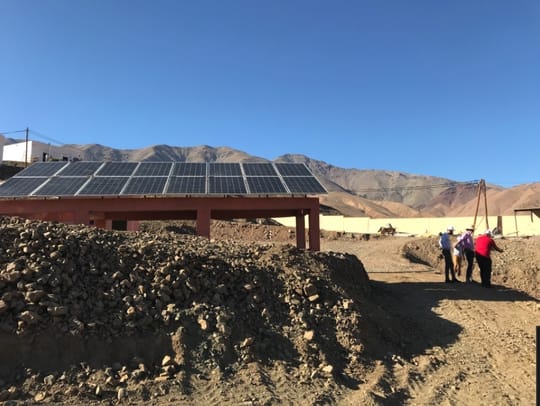Harnessing the Sun: Capitalizing on Morocco’s Most Abundant Resource to Power Transformative Solar-Powered Irrigation Systems


October 2020 – Program partners, Ecosia and USAID’s Farmer-to-Farmer, visit the solar-powered irrigation system at a HAF tree nursery in Ouarzazate province.
Photo by Project Assistant, Hassan Ait Ouatouch.
In a country well known for its expansive desert and dry heat, solar-powered irrigation systems are achieving the impossible by consistently supplying clean water to six High Atlas Foundation (HAF) tree nurseries, creating a cost-effective method to produce and sustain diverse tree crops. Indeed, while Morocco is geographically surrounded by both the expansive Atlantic Ocean and Mediterranean Sea, usable freshwater remains a valuable and extremely limited resource. This is especially pertinent within the agricultural sector, which accounts for the largest percentage of all freshwater withdrawals, and can greatly suffer under the unpredictable rains of the region. Yet, as of 2020, only 15% of the agricultural land in Morocco had been irrigated, resulting in inefficient clean water use and management.The situation is exacerbated by “dwindling groundwater reserves and a lack of functioning sanitation networks and wastewater treatment systems, which causes already scarce water resources to become contaminated and unsuitable for multipurpose use” (USAID). Looking ahead, climate conditions are only expected to deteriorate. By the year 2050, rainfall in Morocco is predicted to decline as much as 20%, greatly increasing the risk of droughts. But while the amount of rainfall cannot be controlled, the manner in which it is used and directed can be. The solar-powered irrigation systems installed throughout HAF’s tree nurseries utilize innovative strategies to distribute Morocco’s limited clean water resources and, in turn, reap economic, agricultural, and environmental benefits.
How do solar-powered irrigation systems work?
The solar-powered irrigation systems used at HAF’s six tree nurseries consist of four main components: the solar panel, the pump, the water tank, and the pipes. The solar panels capture the sunlight’s radiation, and convert this solar energy into electricity. The electrical energy is then used to turn a motor and a flywheel, which preserves mechanical energy for later use. These elements operate the piston, which is responsible for sucking water up, as well as pushing it out. The clean water can be drawn from spring water basins, well water basins, and groundwater resulting from rain. This simple system requires few moving parts, and in turn, less maintenance and expense for the farmer. Consequently, the solar-powered irrigation systems are also relatively easy to put in place, generally requiring less than a week of installation time depending on land size and well depth.
Associated costs and benefits of solar-powered irrigation systems
The use of solar radiation to power the irrigation systems provides significant environmental and economic benefits by eliminating the need for diesel. Solar energy is a free and renewable resource, reducing not only operational costs, but fossil fuel emissions as well. On average, solar pumps save around $60 per month for local associations. This is a notable win for Moroccan communities who have regularly expressed concern for monthly electric bills in district meetings run by HAF. The solar-powered irrigation systems also increase agricultural and economic output by improving yields and reducing vulnerability to unpredictable rainfall. Indeed, reliable irrigation allows for the cultivation of fruit tree varieties, which are far more economically sustainable than the traditional staples of wheat and barley. Additionally, farmers enjoy reduced manual work and improved expenditure of time, as well as enhanced crop resilience and food security. This increase in agricultural productivity is widely acknowledged as an effective way to alleviate poverty and promote socio-economic development. The average cost to install a solar-powered irrigation system is approximately $25,000. While this system can initially seem capital intensive due to the front-loaded investments in solar technology, it easily pays for itself in the form of long-term savings and improved yields.
The crucial role of partnerships
The impact of these solar-powered irrigation systems is without limits, and it is through valuable partnerships that the potential to transform rural communities continues to grow. Currently, HAF has partnered with the National Initiative for Human Development, Ecosia, the United National Development Program, Germanwatch, and others to finance and implement six solar-powered irrigation systems throughout Morocco. The systems currently reside at Salam Primary School fruit tree nursery in Ifrane, the Women’s Cooperative fruit tree nursery in Guercif, the Tassa Ouirgane nursery in Al Haouz, the Akrich fruit tree nursery in Al Haouz, the Tadmant fruit tree nursery in Al Haouz, and the Aguim nursery near Ouarzazate. Electronic manufacturing nonprofit, FENELEC, or the National Federation of Electricity, Electronics, and Renewable Energies, is another of these crucial supporters, providing pumps, solar panels, control cabinets, and piping to solar pumping systems at the Akrich and Tadmant fruit tree nurseries.
On Sunday, February 28, 2021, the High Atlas Foundation inaugurated the solar water pumping system at the Akrich nursery, a national nursery planted on land lent in-kind by the Moroccan Jewish Community.
The tremendous economic, agricultural, and environmental benefits derived from solar-powered irrigation systems wouldn’t be possible without the generous donations of our partners. Learn more about how you can support irrigation projects here.